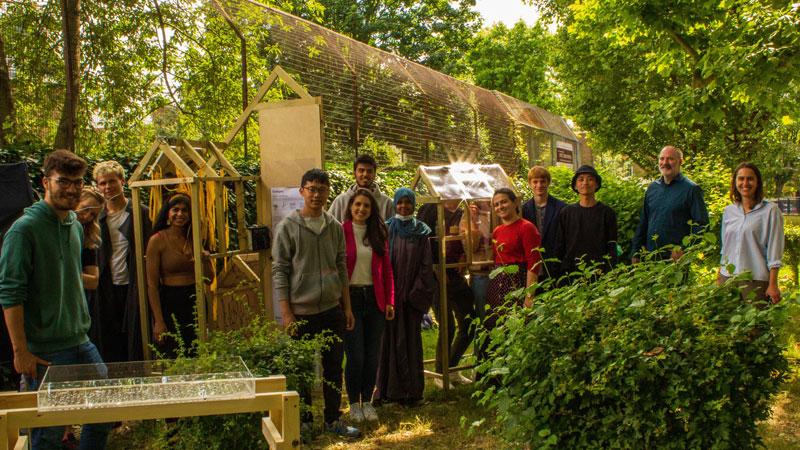Students from the University of Westminster have collaborated with St John the Divine Primary School in Kennington to design interactive playground installations that demonstrate the science of buildings and their interaction with climate and biodiversity.

Students across the School of Architecture + Cities worked collaboratively in teams, engaging with primary school students and supported by mentors from local architectural practices. Each team explored a specific issue of climate change, designing and building an interactive playground demonstration installation to support science curriculum learning for nine to ten year-old school students.
The issues included ‘Energy’, demonstrating principles of converting solar or wind energy into electricity; ‘Heat’, demonstrating the effect of insulation and passive cooling; ‘Ecology’, demonstrating principles of biodiversity through the study of urban habitats; ‘Global Warming’, demonstrating the impact of temperature increase on glacial ice melt and sea level rise; and ‘Water’, demonstrating the problem of rain-water run-off in cities.
In the first stage, students participated in an intensive one-day design workshop to develop their ideas and make a concept model of the design, which were then taken to the primary school for discussion and debate. In the second stage, students produced fabrication and constructed the final works. The installations were then taken to the school on Friday 25 June for a day of interaction and exhibition with children at the school and for display to the public for viewing as part of the London Festival of Architecture.
Generously funded by the Quintin Hogg Trust, Climate Demonstrator is part of a larger funding strategy that is likely to develop into a more substantial and permanent project around climate and biodiversity in the next academic year. The summer school is also supported by local architectural practices Formation Architects and DSDHA, which provided mentorship to the students throughout the duration of the workshop.
After a year of isolated working, the project gave students the chance to celebrate a return to face-to-face life and hands-on making. They also benefitted from developing their organisational and project management skills, making contact with architects, stakeholders and the school’s community, as well as having their work displayed in a public exhibition as part of the London Festival of Architecture.
Talking about the project, Julian Williams RIBA, Principal Lecturer at the School of Architecture + Cities, said: “Students relished the opportunity to once again work hands-on and together with a clear educational purpose, working through collaborative designing and making and through dialogue with young learners. The project was driven by an immense enthusiasm and energy to do things in the world, and to share knowledge and ideas about sustainability.”
Pablo, a student who took part in the summer school, added: “The summer school was a fantastic experience I would recommend to anyone. As a first-year student it was a great way to meet other students from different years and collaborate with them on a project which involved a lot of team production and hard work. Seeing the kids playing and learning with our creations was a fulfilling thing to behold. I learned a lot and the experience has made me feel more prepared and confident for the future of my studies.”
Find out more about the Climate Demonstrator project.
Learn more about Architecture, Interiors and Urban Design courses at the University of Westminster.


